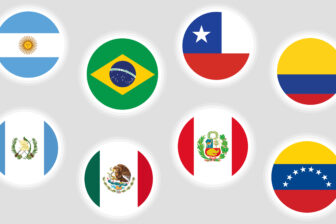Up and down the ballot, Democrats outperformed expectations in U.S. midterm elections held November 8, staving off what many predicted would be a wipeout by Republicans—except in one state: Florida. There, incumbent Governor Ron DeSantis and Senator Marco Rubio each beat their Democratic challengers by close to 20 points. Both looked on track to win Miami Dade county—historically a blue stronghold home to 1.5 million Latino voters—by margins of about 10 points. And exit polls showed DeSantis winning the state’s Latino voters by 13 points.
The results seemed to confirm that Florida’s shift from purple to red is here to stay. Not everyone on the left mourned the loss. Matt Duss, a progressive foreign policy figurehead and advisor to Senator Bernie Sanders’ 2016 presidential campaign, tweeted the equivalent of good riddance: “FL going full red can enable Dems to stop pandering to hawkish conservatives on Latin America.”
Duss’s tweet spoke to a widely held perception about U.S. policy towards Latin America—that it’s decided by, and largely for, a small electorate in South Florida that keeps the hands of Democratic leadership tied. If Democrats stop viewing Florida as a swing state, the thinking goes, the constraints disappear.
There’s only one problem: The constraints are already gone. When it comes to hot-button issues—Venezuela policy, Cuba policy and diplomatic relations with Latin America’s leftist governments—Biden hasn’t been walking on eggshells.
Take Venezuela. In March, senior administration officials traveled to Caracas to try to lure Nicolás Maduro back to the negotiating table with the country’s democratic opposition and secured the release of two U.S. prisoners. Two months later, the Treasury Department renewed a license partially exempting Chevron from oil sanctions. An October prisoner swap freed seven more jailed U.S. citizens, and in November, Maduro and the opposition announced they were preparing to resume talks. Meanwhile, the Biden administration refused to get involved in infighting among the opposition over whether Juan Guaidó, whom the U.S. recognizes as Venezuela’s Interim President, will remain its leader.
Secretary of State Antony Blinken told reporters last month, “On Venezuela, there is no change in our policy or approach,” but it’s a hard point to argue. Before the midterms, and despite smears from both Rubio and DeSantis, Biden had already moved away from Trump’s ultimately ineffective “maximum pressure” strategy.
Florida’s new shade of red won’t dramatically shake up Cuba policy, either. First, Cuba policy already has changed. In late October, the administration announced that the U.S. Agency for International Development would provide an unprecedented $2 million in disaster relief to Cuban communities devastated by Hurricane Ian, routed through independent humanitarian organizations. Earlier this year, the administration also reinstated a program allowing Cubans to apply to bring family members legally to the U.S. and moved towards lifting a cap on remittances. True, none of this means a wholesale reversal of the hardening of Cuba policy under Trump. But if the environment isn’t there for a major policy shift, don’t blame South Florida; it’s the Cuban regime standing in the way. Over the past year, the regime sentenced nearly 400 peaceful protestors to decades behind bars, which Senate Democrats and the Biden administration condemned in strong terms. Regardless of U.S. electoral politics, Cuba’s crackdown hasn’t made a new détente easy.
Last, Biden has already shown that Florida politics will not constrain diplomatic outreach across the rest of the hemisphere. When Gustavo Petro was elected Colombia’s first leftist president earlier this year, DeSantis called him a “former narco-terrorist and a Marxist” and blasted the outcome as “disastrous.” But that—and South Florida’s large Colombian population, which broke decisively for Petro’s challenger—didn’t stop the administration from offering to work together with the Petro government on shared priorities or aiding implementation of Colombia’s Peace Accord by delisting the FARC as a terrorist organization.
All in all, Biden has not tiptoed around issues that set South Florida alight. But he—and many Democrats who picked up midterm seats—have done so with regard to another hot-button issue that has major implications for both regional foreign policy and national elections: immigration.
Border-First Diplomacy
If there is any similarity between Trump’s and Biden’s foreign policy agendas in Latin America, it’s that they have both made reducing record-setting migration flows their top diplomatic priority—in Biden’s case, even when it has meant big compromises.
No one was surprised when Trump, who ran on an explicitly anti-immigration platform in 2016, took a transactional approach to regional foreign policy: So long as governments in Central America and Mexico detained migrants, they received a blank check to dismantle democracy and commit abuses. In 2020, Biden campaigned on reversing course. In his first months in office, curbing corruption and democratic erosion in Central America became a dominant theme, if not the theme, of the new administration’s Western Hemisphere policy. Although nowhere near as intense as the sectoral sanctions applied to Venezuela or Cuba, the State Department blocked visas for hundreds of allegedly anti-democratic and corrupt actors from Guatemala, El Salvador and Honduras, and froze some of their U.S.-held assets.
But in 2022, as a record-setting number of migrants and refugees arrived at the U.S.-Mexico border, there were signs that priorities might be changing. For instance, although the Department of Justice suspended cooperation with Guatemala’s attorney general for persecuting critics of President Alejandro Giammattei, the U.S. Customs and Border Protection (CBP) commissioner congratulated the prosecutor’s office for arresting migrant smugglers. In October, Guatemala’s government—despite threatening to kick USAID out of the country for its work with civil society—received a $4.4 million donation to bolster border policing that skirted a State Department ban on financing Guatemala’s military.
Meanwhile, as Mexican President Andrés Manuel López Obrador weakened democratic checks and moved to dismantle the country’s independent electoral authority, the Biden administration was virtually silent. This may come as a surprise, unless you consider that López Obrador simultaneously promised to take in an increasing number of migrants blocked or expelled at the southern border. Even Biden’s shifts on Venezuela and Cuba policy seemed geared towards reducing the historic number of migrants arriving to U.S. borders from both countries this year.
Border-first diplomacy, if you could call it that, seems here to stay—at least as long as Democrats see increased migration as an electoral liability. South Florida might be a lost cause for Democrats. But South Texas could come to replace it as an increasingly important purple battleground, as narrow wins by conservative Democrats like Henry Cuellar and Vicente Gonzalez demonstrated. Both candidates campaigned on hardline border policies which Democrats may come to perceive as important for winning over South Texas’s millions of Latino voters and possibly flipping the state.
In the long-run, border-first diplomacy is likely to prove equally—if not more—constrictive to Democrats’ foreign policy towards Latin America than the limitations of old, if only because migrants are arriving from everywhere in the region, not just its few dictatorships. That would be unfortunate.
In the past, when the U.S. has based its policies towards Latin America on a single narrow concern—whether anti-communism, containing the next Hugo Chávez or stemming migration—it has never worked out well. Even so, U.S. domestic politics will continue to shape policy towards the Americas. The new challenge—developing a broader regional policy that moves beyond the electoral pressures of the day—will be the same as the old.









